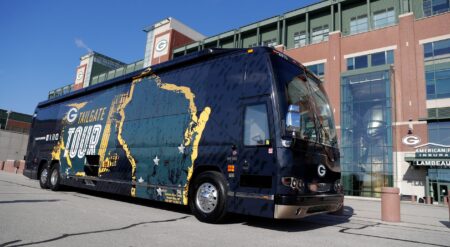Sponsors are everywhere you look in sports and NFL culture is right at the fore.
Take a look around at any NFL stadium and you will see sponsorship logos and insignia — if not directly in the name, at least in the merchandising and concessions. The same is true in most professional sports leagues.
Some of the examples are more overt. Take Formula One, where the teams are named after the companies that sponsor them – such as Mercedes, Ferrari and Red Bull. Not only are the cars covered wheel to wheel with sponsorships from all over the world, but the drivers’ uniforms are also decked out – with logos almost seemingly battling for space on the jumpsuit.
There are also more undercover sponsorships – such as Soldier Field or MetLife Stadium only serving Coca-Cola products or a team’s uniforms only being created using Nike or Adidas clothing items.
Then there are the companies which sponsor activities associated with the teams, such as sports betting (football isn’t the only sport that benefits from this kind of sponsorship. Basketball is a popular sport to bet on among fans due to the high scoring games, enticing sports betting sponsors, especially for the NBA), VIP fan experiences or merchandise. Together, each of these elements creates a cohesive experience. Just look at the NFL – Bud Light connection.
Bud Light cans and bottles for 2021 NFL season. pic.twitter.com/otg7JsgLIY
— Darren Rovell (@darrenrovell) August 19, 2021
Sponsorship a method of patronage
At the genesis of organized sports, sports sponsorship was seen as a method of patronage. Where wealthy elites would sponsor their favorite athletes and team and ensure they had all the resources needed to be successful.
However, according to research produced by Price Waterhouse Coopers (PwC) in 2021, the global sports market is projected to exceed $73.5bn. This is unsurprising considering the number of athletes, teams and leagues which exist in every corner of the world.
We have become so accustomed to this ad-exposure that often we do not even realize that we become billboards ourselves when we buy our favorite team’s jersey.
These sponsorships were, and still are, incredibly important because they enable companies to gain exposure and become fan favorites – while also providing teams with a source of income as well as stability.
There are few other arenas where fans have the same deep loyalty and passion than sports. So, when brands successfully integrate into a team they can access this loyalty – and loyalty is a commodity that does not expire.
In addition to the financial benefits afforded to teams, they are also able to experience the status that certain partnerships imply. This is especially true when popular global brands, with phenomenal name recognition, decide to align with a team.
Fans like supporting their teams and remembering the highlights – and these companies ensure that the teams stay around long enough to ensure those happy memories are passed from one generation to the next.
Sponsorships Shape NFL Culture
However, the question must be asked: how do these sponsorships shape culture – especially in sports such as NFL football?
For years, this question was considered in the context of fan experience. For example, if a partnership with a clothing company resulted in sub-par merchandise that fans were not interested in, then that sponsorship might need to be evaluated.
However, as the internet gained traction and people became more aware of the actions of certain companies, the partnership model of money from companies for exposure via sports teams began to be challenged.
There are many examples of fans becoming aware of problems and demanding companies fix them, but also demanding teams boycott the products.
One of the most famous is the Nike scandal of 1991, when Jeff Ballinger released a report which detailed the wretched working conditions of Nike’s factories in Indonesia. It prompted a national uproar, and many demanded that sports teams and athletes end their partnerships and refuse Nike products.
Another example occurred in 2016, when San Francisco 49ers Quarterback Colin Kaepernick protested police violence by kneeling during the national anthem – immediately, debate around the ethics, message and purpose developed. What resulted was a massive movement across many sports teams with individual athletes aligning with Kaepernick and demanding attention for police violence.
Sponsors responded by either demonstrating an alliance to this movement and the larger Black Lives Matter movement or distancing themselves from it. Some companies asked him to be a spokesperson and others threatened to terminate their partnership with the NFL as a whole.
Depending on whether people agreed or disagreed with Kaepernick’s behavior and message, they in turn supported brands which associated with their beliefs.
Nike felt the brunt of this treatment when in 2018 they produced an ad with Kaepernick and hundreds of people responded by burning their Nike clothing, shoes and accessories.
Former NFL quarterback and social activist Colin Kaepernick says it would be financially beneficial for a team to sign him:
“When I did the deal with Nike, their value increased by $6 billion. 6 billion with a B.” pic.twitter.com/L88utAoqr9
— The Recount (@therecount) April 19, 2022
This is an essential example of how sponsorships are a two-way street in terms of influence. As the NFL culture, and that of other organizations as well, demands space in a growing sports industry, the alliances they make might have short-term benefits. The long-term consequences which the teams might not recover from.
Above all else – it is important for football teams to be aware of the reputation and behaviors of their sponsors because they represent the people who support them.
Lifelong sports fans deserve to identify with teams that demand the best of their sponsors.





